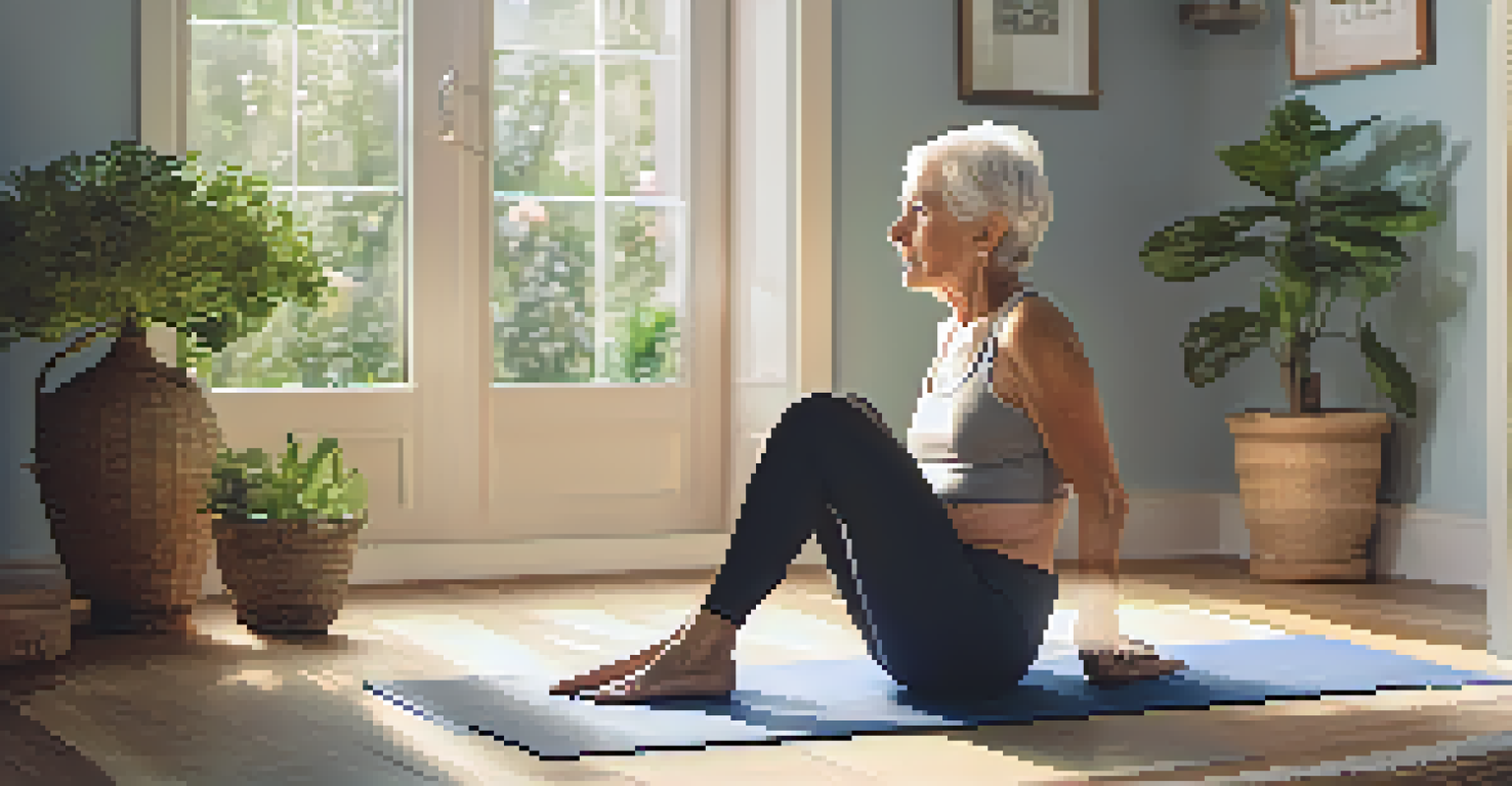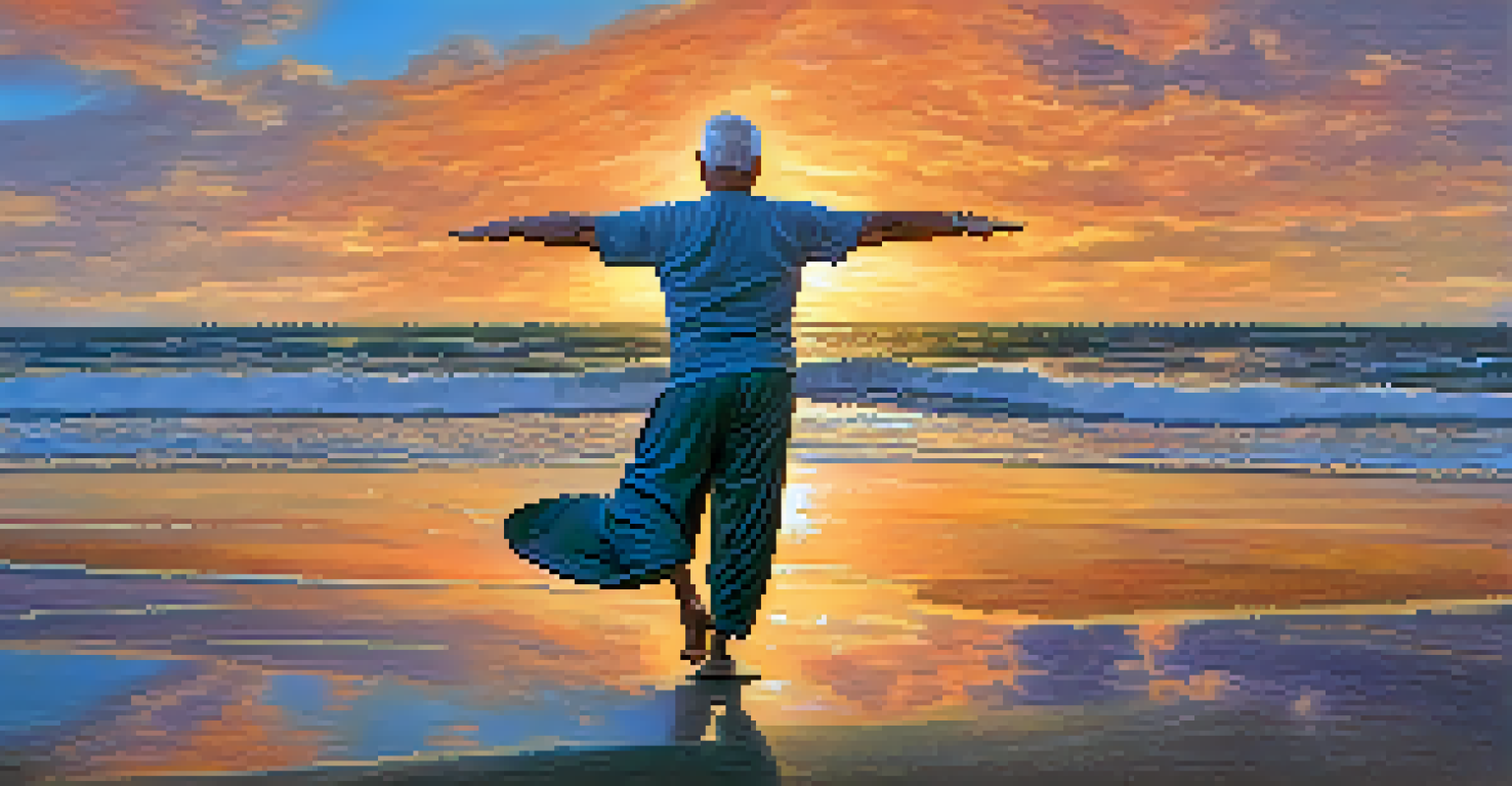Yoga and Aging: Maintaining Flexibility and Strength

Understanding the Benefits of Yoga for Aging Bodies
As we age, our bodies undergo numerous changes that can affect flexibility and strength. Yoga provides a gentle yet effective way to counter these changes, promoting overall well-being. Through mindful movement and breathwork, yoga helps enhance flexibility, enabling older adults to maintain a greater range of motion.
Yoga is the journey of the self, through the self, to the self.
Additionally, practicing yoga strengthens muscles, supporting joint health and reducing the risk of injury. It’s not just about physical benefits; yoga also cultivates mental clarity and emotional resilience. This holistic approach makes yoga a powerful ally in navigating the aging process.
Ultimately, incorporating yoga into your routine can foster a sense of empowerment, helping you feel more in control of your body and health. Whether you’re a beginner or have been practicing for years, the benefits of yoga are accessible to everyone.
How Yoga Improves Flexibility with Age
Flexibility often declines with age, leading to stiffness and discomfort. Yoga encourages gentle stretching and movement, which can help counteract this decline. Poses like Downward Dog or Cat-Cow not only stretch muscles but also improve circulation, ensuring that joints remain lubricated and healthy.

Moreover, the focus on breath during yoga helps deepen stretches and promotes a greater awareness of your body. This awareness is crucial as it allows you to listen to your body’s needs and limits, preventing injury while enhancing flexibility over time. Regular practice can lead to noticeable improvements in how you move throughout the day.
Incorporating a variety of poses into your routine can keep the practice engaging and beneficial. Even simple stretches can lead to significant gains in flexibility, making daily activities easier and more enjoyable.
Building Strength Through Yoga Practice
While flexibility is essential, strength is equally important for aging gracefully. Yoga poses such as Warrior II or Chair Pose engage multiple muscle groups, promoting overall strength. These poses not only tone muscles but also enhance balance, which is crucial for preventing falls.
The body benefits from movement, and the mind benefits from stillness.
Fostering strength through yoga can improve your ability to perform everyday activities, from lifting groceries to climbing stairs. It’s about functional fitness, ensuring that you can lead an independent and active life. Plus, the focus on alignment and core stability in yoga helps create a solid foundation for strength.
Consistency is key when it comes to building strength through yoga. By regularly practicing strength-building poses, you’ll notice improvements not only in your physical capabilities but also in your confidence and body awareness.
Mindfulness: A Key Component of Yoga and Aging
Mindfulness is an integral part of yoga, promoting a deeper connection between body and mind. As we age, cultivating mindfulness can reduce stress and enhance mental well-being. By focusing on your breath and movements, you can create a meditative state that calms the mind and promotes relaxation.
This mental clarity can be particularly beneficial in managing age-related challenges, such as anxiety or memory issues. Practicing mindfulness through yoga encourages a positive outlook, helping you embrace aging with grace and acceptance. It’s about being present in the moment, appreciating your body for what it can do.
Mindfulness in yoga also fosters a spirit of self-compassion, allowing you to honor your body’s limitations while celebrating its strengths. This compassionate approach can transform your relationship with aging, making it a more enjoyable journey.
Creating a Safe Yoga Practice for Seniors
Safety is paramount when practicing yoga, especially for older adults. It’s essential to choose poses that are appropriate for your level of flexibility and strength. Starting with gentle classes or beginner-friendly sequences can ensure that you build a solid foundation without pushing your limits too quickly.
Using props like blocks, straps, or chairs can provide additional support, making poses more accessible. Listening to your body is crucial; if something doesn’t feel right, it’s okay to modify or skip that pose. Your yoga practice should be a source of joy, not discomfort.
Consulting with a qualified instructor who understands the needs of seniors can enhance your practice. They can guide you in developing a safe and effective routine tailored to your specific abilities and goals.
Incorporating Yoga into Your Daily Routine
Integrating yoga into your daily life doesn’t have to be overwhelming. Even a few minutes of practice each day can yield significant benefits. Consider starting your morning with a short routine to wake up your body or winding down in the evening with gentle stretches to promote relaxation.
You can also explore online classes or community classes tailored for seniors, providing you with guidance and the opportunity to connect with others. Finding a routine that fits your lifestyle is key; whether it’s a 10-minute session or a longer practice, consistency is what counts.
Remember, yoga is a personal journey. It’s not about achieving perfect poses but rather about enjoying the process of movement and self-discovery. Celebrate small victories, and over time, you'll notice how yoga enriches your life.
Success Stories: Real Benefits of Yoga for Seniors
Many seniors have shared inspiring stories about how yoga has transformed their lives. From improved flexibility to newfound strength, these personal accounts highlight the profound impact yoga can have on aging bodies. One participant noted that after a few months of practice, she could touch her toes again, something she hadn’t been able to do in years.
Another individual shared how yoga helped alleviate chronic pain, allowing them to enjoy everyday activities again. These testimonials serve as powerful reminders that it’s never too late to start a yoga practice and reap its benefits.

Hearing these stories can motivate others to begin their journey. Ultimately, yoga offers a supportive community and a pathway to better health as we age, proving that flexibility and strength are attainable at any stage of life.